2017 NISSAN LEAF instrument panel
[x] Cancel search: instrument panelPage 122 of 424
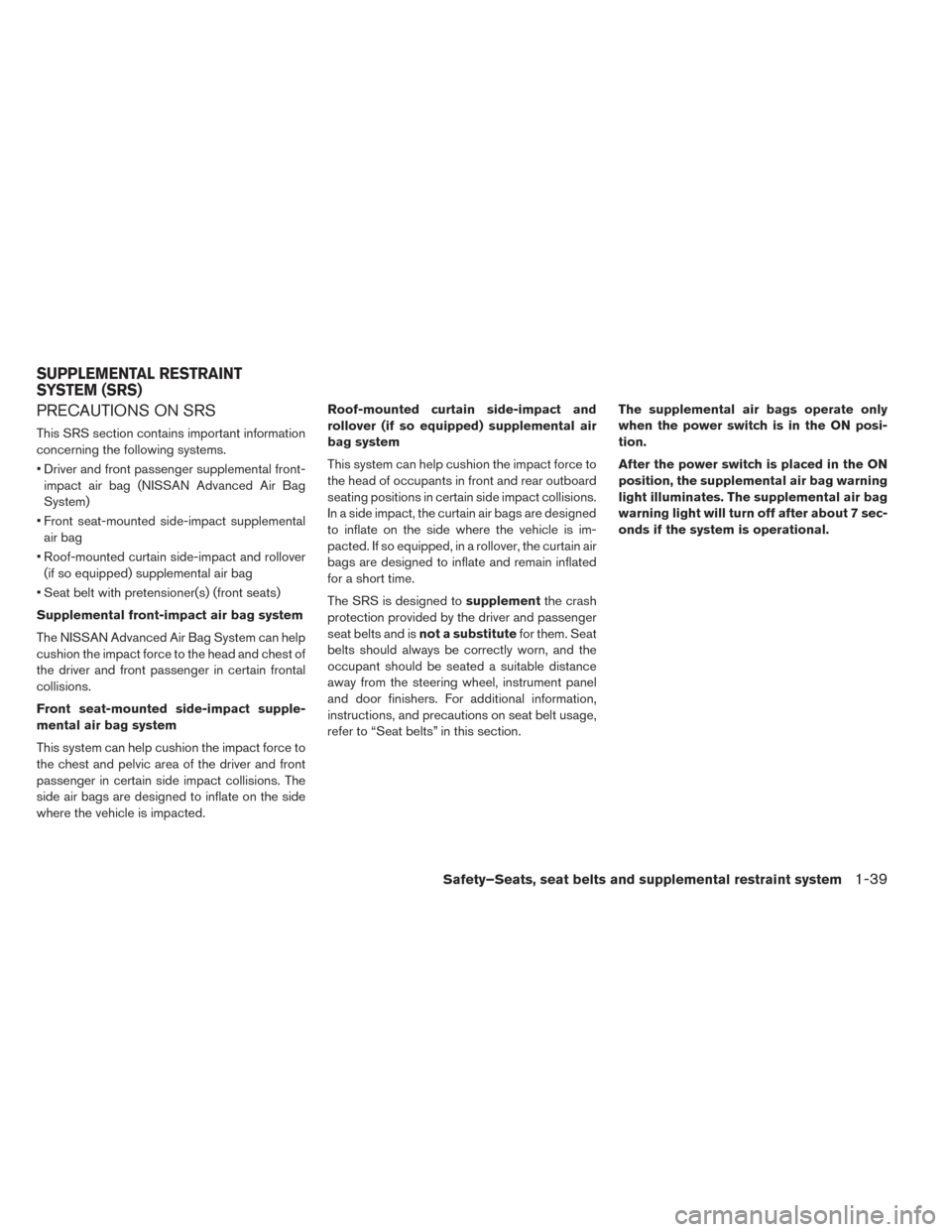
PRECAUTIONS ON SRS
This SRS section contains important information
concerning the following systems.
• Driver and front passenger supplemental front-impact air bag (NISSAN Advanced Air Bag
System)
• Front seat-mounted side-impact supplemental air bag
• Roof-mounted curtain side-impact and rollover (if so equipped) supplemental air bag
• Seat belt with pretensioner(s) (front seats)
Supplemental front-impact air bag system
The NISSAN Advanced Air Bag System can help
cushion the impact force to the head and chest of
the driver and front passenger in certain frontal
collisions.
Front seat-mounted side-impact supple-
mental air bag system
This system can help cushion the impact force to
the chest and pelvic area of the driver and front
passenger in certain side impact collisions. The
side air bags are designed to inflate on the side
where the vehicle is impacted. Roof-mounted curtain side-impact and
rollover (if so equipped) supplemental air
bag system
This system can help cushion the impact force to
the head of occupants in front and rear outboard
seating positions in certain side impact collisions.
In a side impact, the curtain air bags are designed
to inflate on the side where the vehicle is im-
pacted. If so equipped, in a rollover, the curtain air
bags are designed to inflate and remain inflated
for a short time.
The SRS is designed to
supplementthe crash
protection provided by the driver and passenger
seat belts and is not a substitute for them. Seat
belts should always be correctly worn, and the
occupant should be seated a suitable distance
away from the steering wheel, instrument panel
and door finishers. For additional information,
instructions, and precautions on seat belt usage,
refer to “Seat belts” in this section. The supplemental air bags operate only
when the power switch is in the ON posi-
tion.
After the power switch is placed in the ON
position, the supplemental air bag warning
light illuminates. The supplemental air bag
warning light will turn off after about 7 sec-
onds if the system is operational.
SUPPLEMENTAL RESTRAINT
SYSTEM (SRS)
Safety–Seats, seat belts and supplemental restraint system1-39
Page 123 of 424
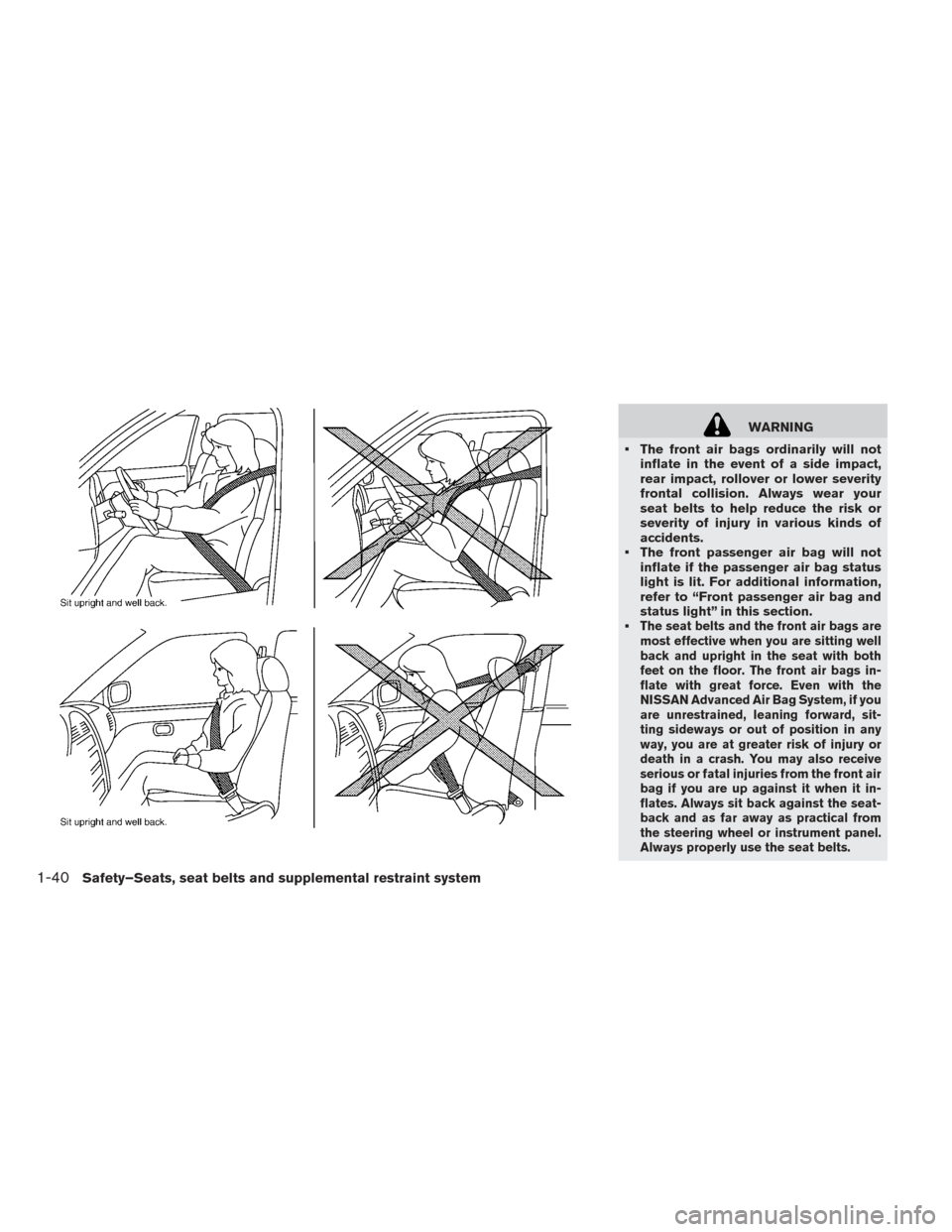
WARNING
• The front air bags ordinarily will not inflate in the event of a side impact,
rear impact, rollover or lower severity
frontal collision. Always wear your
seat belts to help reduce the risk or
severity of injury in various kinds of
accidents.
• The front passenger air bag will not inflate if the passenger air bag status
light is lit. For additional information,
refer to “Front passenger air bag and
status light” in this section.
•
The seat belts and the front air bags are
most effective when you are sitting well
back and upright in the seat with both
feet on the floor. The front air bags in-
flate with great force. Even with the
NISSAN Advanced Air Bag System, if you
are unrestrained, leaning forward, sit-
ting sideways or out of position in any
way, you are at greater risk of injury or
death in a crash. You may also receive
serious or fatal injuries from the front air
bag if you are up against it when it in-
flates. Always sit back against the seat-
back and as far away as practical from
the steering wheel or instrument panel.
Always properly use the seat belts.
1-40Safety–Seats, seat belts and supplemental restraint system
Page 128 of 424
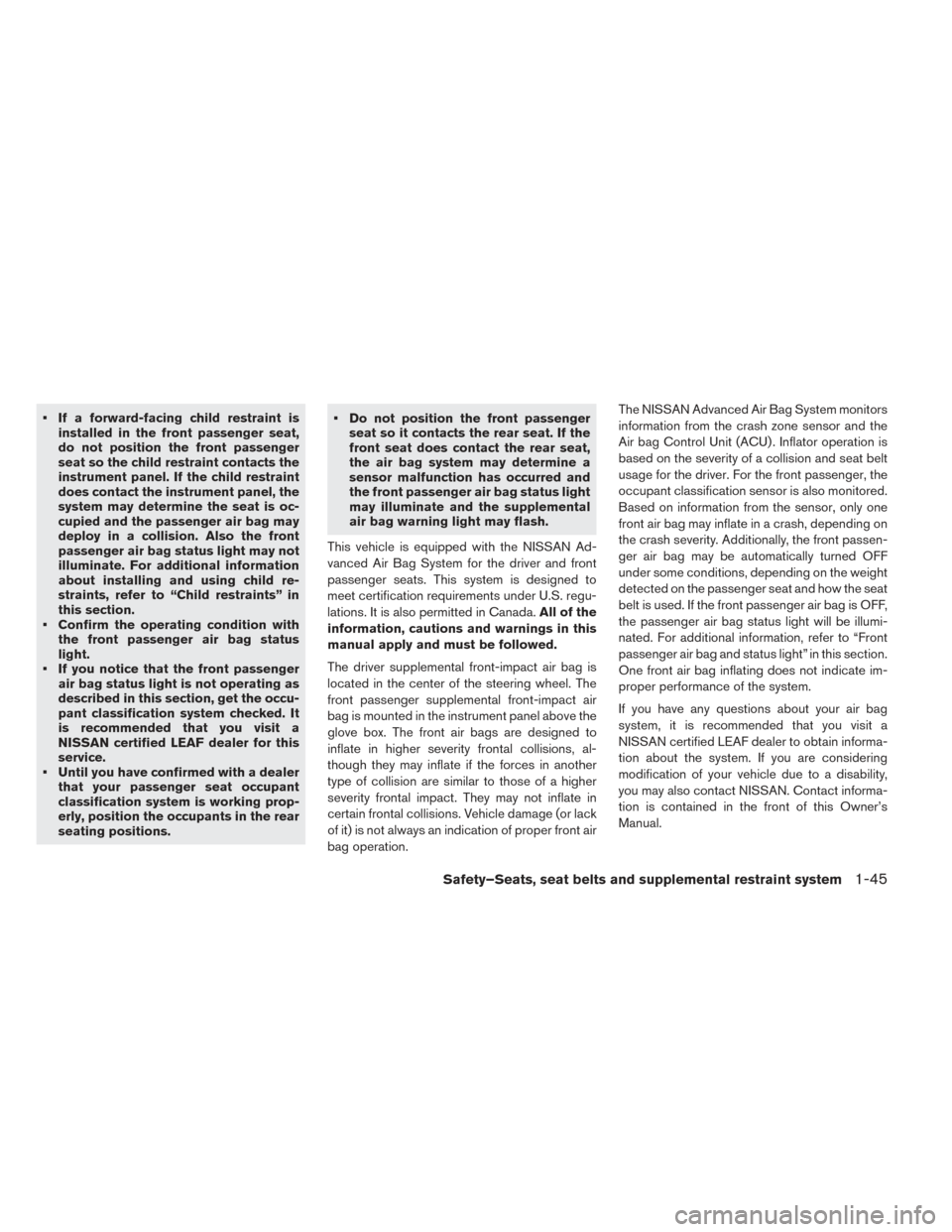
• If a forward-facing child restraint isinstalled in the front passenger seat,
do not position the front passenger
seat so the child restraint contacts the
instrument panel. If the child restraint
does contact the instrument panel, the
system may determine the seat is oc-
cupied and the passenger air bag may
deploy in a collision. Also the front
passenger air bag status light may not
illuminate. For additional information
about installing and using child re-
straints, refer to “Child restraints” in
this section.
• Confirm the operating condition with the front passenger air bag status
light.
• If you notice that the front passenger air bag status light is not operating as
described in this section, get the occu-
pant classification system checked. It
is recommended that you visit a
NISSAN certified LEAF dealer for this
service.
• Until you have confirmed with a dealer that your passenger seat occupant
classification system is working prop-
erly, position the occupants in the rear
seating positions. • Do not position the front passenger
seat so it contacts the rear seat. If the
front seat does contact the rear seat,
the air bag system may determine a
sensor malfunction has occurred and
the front passenger air bag status light
may illuminate and the supplemental
air bag warning light may flash.
This vehicle is equipped with the NISSAN Ad-
vanced Air Bag System for the driver and front
passenger seats. This system is designed to
meet certification requirements under U.S. regu-
lations. It is also permitted in Canada. All of the
information, cautions and warnings in this
manual apply and must be followed.
The driver supplemental front-impact air bag is
located in the center of the steering wheel. The
front passenger supplemental front-impact air
bag is mounted in the instrument panel above the
glove box. The front air bags are designed to
inflate in higher severity frontal collisions, al-
though they may inflate if the forces in another
type of collision are similar to those of a higher
severity frontal impact. They may not inflate in
certain frontal collisions. Vehicle damage (or lack
of it) is not always an indication of proper front air
bag operation. The NISSAN Advanced Air Bag System monitors
information from the crash zone sensor and the
Air bag Control Unit (ACU) . Inflator operation is
based on the severity of a collision and seat belt
usage for the driver. For the front passenger, the
occupant classification sensor is also monitored.
Based on information from the sensor, only one
front air bag may inflate in a crash, depending on
the crash severity. Additionally, the front passen-
ger air bag may be automatically turned OFF
under some conditions, depending on the weight
detected on the passenger seat and how the seat
belt is used. If the front passenger air bag is OFF,
the passenger air bag status light will be illumi-
nated. For additional information, refer to “Front
passenger air bag and status light” in this section.
One front air bag inflating does not indicate im-
proper performance of the system.
If you have any questions about your air bag
system, it is recommended that you visit a
NISSAN certified LEAF dealer to obtain informa-
tion about the system. If you are considering
modification of your vehicle due to a disability,
you may also contact NISSAN. Contact informa-
tion is contained in the front of this Owner’s
Manual.
Safety–Seats, seat belts and supplemental restraint system1-45
Page 129 of 424
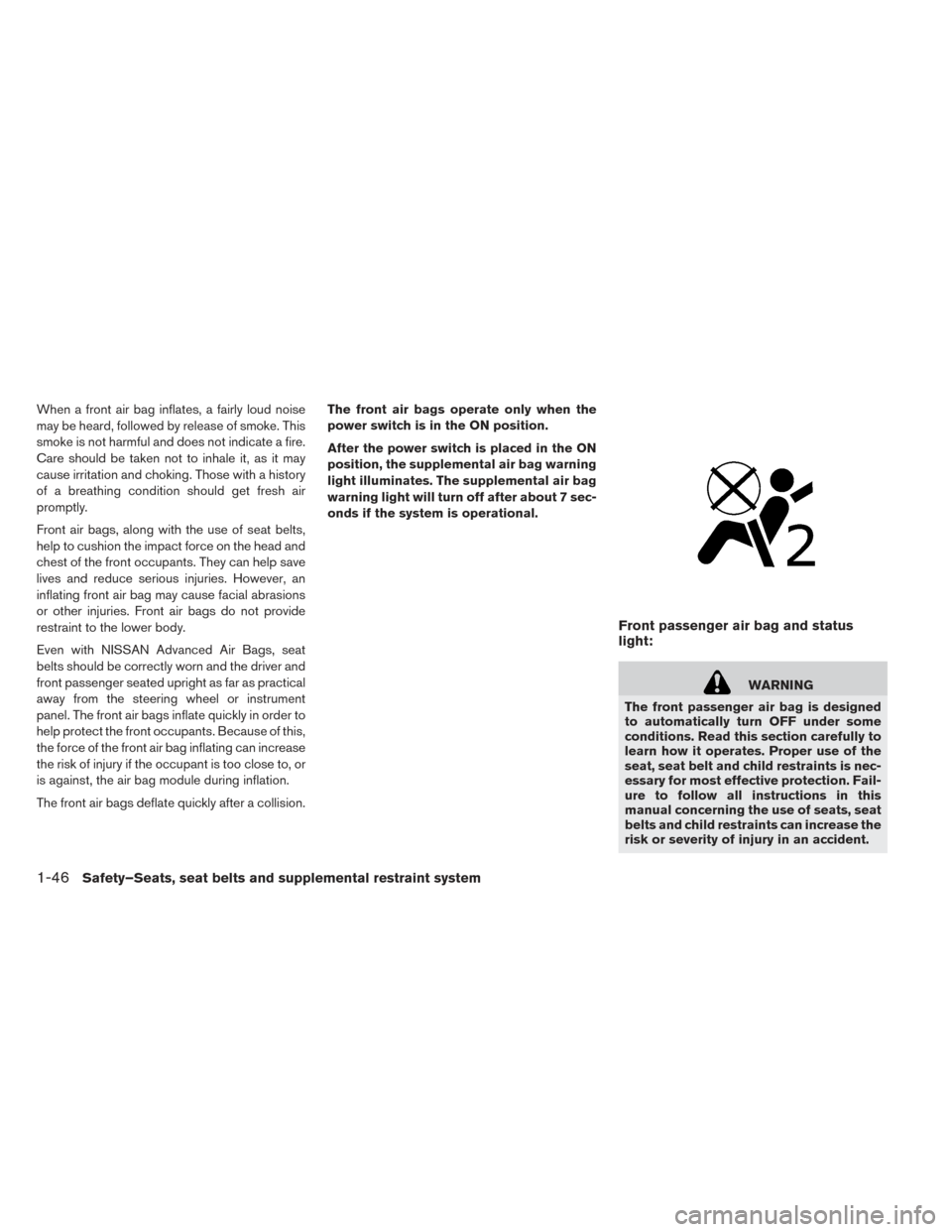
When a front air bag inflates, a fairly loud noise
may be heard, followed by release of smoke. This
smoke is not harmful and does not indicate a fire.
Care should be taken not to inhale it, as it may
cause irritation and choking. Those with a history
of a breathing condition should get fresh air
promptly.
Front air bags, along with the use of seat belts,
help to cushion the impact force on the head and
chest of the front occupants. They can help save
lives and reduce serious injuries. However, an
inflating front air bag may cause facial abrasions
or other injuries. Front air bags do not provide
restraint to the lower body.
Even with NISSAN Advanced Air Bags, seat
belts should be correctly worn and the driver and
front passenger seated upright as far as practical
away from the steering wheel or instrument
panel. The front air bags inflate quickly in order to
help protect the front occupants. Because of this,
the force of the front air bag inflating can increase
the risk of injury if the occupant is too close to, or
is against, the air bag module during inflation.
The front air bags deflate quickly after a collision.The front air bags operate only when the
power switch is in the ON position.
After the power switch is placed in the ON
position, the supplemental air bag warning
light illuminates. The supplemental air bag
warning light will turn off after about 7 sec-
onds if the system is operational.
Front passenger air bag and status
light:
WARNING
The front passenger air bag is designed
to automatically turn OFF under some
conditions. Read this section carefully to
learn how it operates. Proper use of the
seat, seat belt and child restraints is nec-
essary for most effective protection. Fail-
ure to follow all instructions in this
manual concerning the use of seats, seat
belts and child restraints can increase the
risk or severity of injury in an accident.
1-46Safety–Seats, seat belts and supplemental restraint system
Page 130 of 424
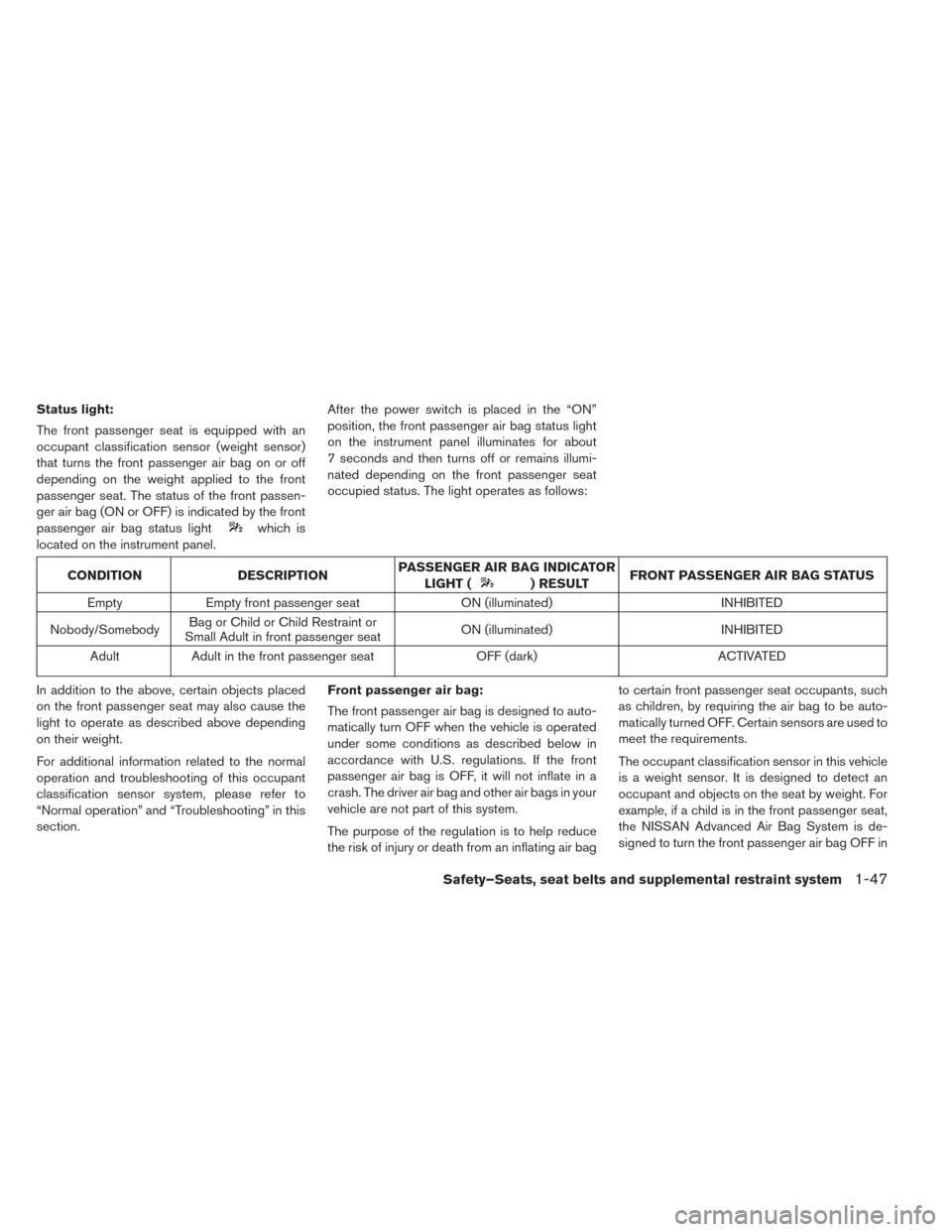
Status light:
The front passenger seat is equipped with an
occupant classification sensor (weight sensor)
that turns the front passenger air bag on or off
depending on the weight applied to the front
passenger seat. The status of the front passen-
ger air bag (ON or OFF) is indicated by the front
passenger air bag status light
which is
located on the instrument panel. After the power switch is placed in the “ON”
position, the front passenger air bag status light
on the instrument panel illuminates for about
7 seconds and then turns off or remains illumi-
nated depending on the front passenger seat
occupied status. The light operates as follows:
CONDITION
DESCRIPTIONPASSENGER AIR BAG INDICATOR
LIGHT () RESULT FRONT PASSENGER AIR BAG STATUS
Empty Empty front passenger seat ON (illuminated) INHIBITED
Nobody/Somebody Bag or Child or Child Restraint or
Small Adult in front passenger seat ON (illuminated)
INHIBITED
Adult Adult in the front passenger seat OFF (dark)ACTIVATED
In addition to the above, certain objects placed
on the front passenger seat may also cause the
light to operate as described above depending
on their weight.
For additional information related to the normal
operation and troubleshooting of this occupant
classification sensor system, please refer to
“Normal operation” and “Troubleshooting” in this
section. Front passenger air bag:
The front passenger air bag is designed to auto-
matically turn OFF when the vehicle is operated
under some conditions as described below in
accordance with U.S. regulations. If the front
passenger air bag is OFF, it will not inflate in a
crash. The driver air bag and other air bags in your
vehicle are not part of this system.
The purpose of the regulation is to help reduce
the risk of injury or death from an inflating air bagto certain front passenger seat occupants, such
as children, by requiring the air bag to be auto-
matically turned OFF. Certain sensors are used to
meet the requirements.
The occupant classification sensor in this vehicle
is a weight sensor. It is designed to detect an
occupant and objects on the seat by weight. For
example, if a child is in the front passenger seat,
the NISSAN Advanced Air Bag System is de-
signed to turn the front passenger air bag OFF in
Safety–Seats, seat belts and supplemental restraint system1-47
Page 132 of 424
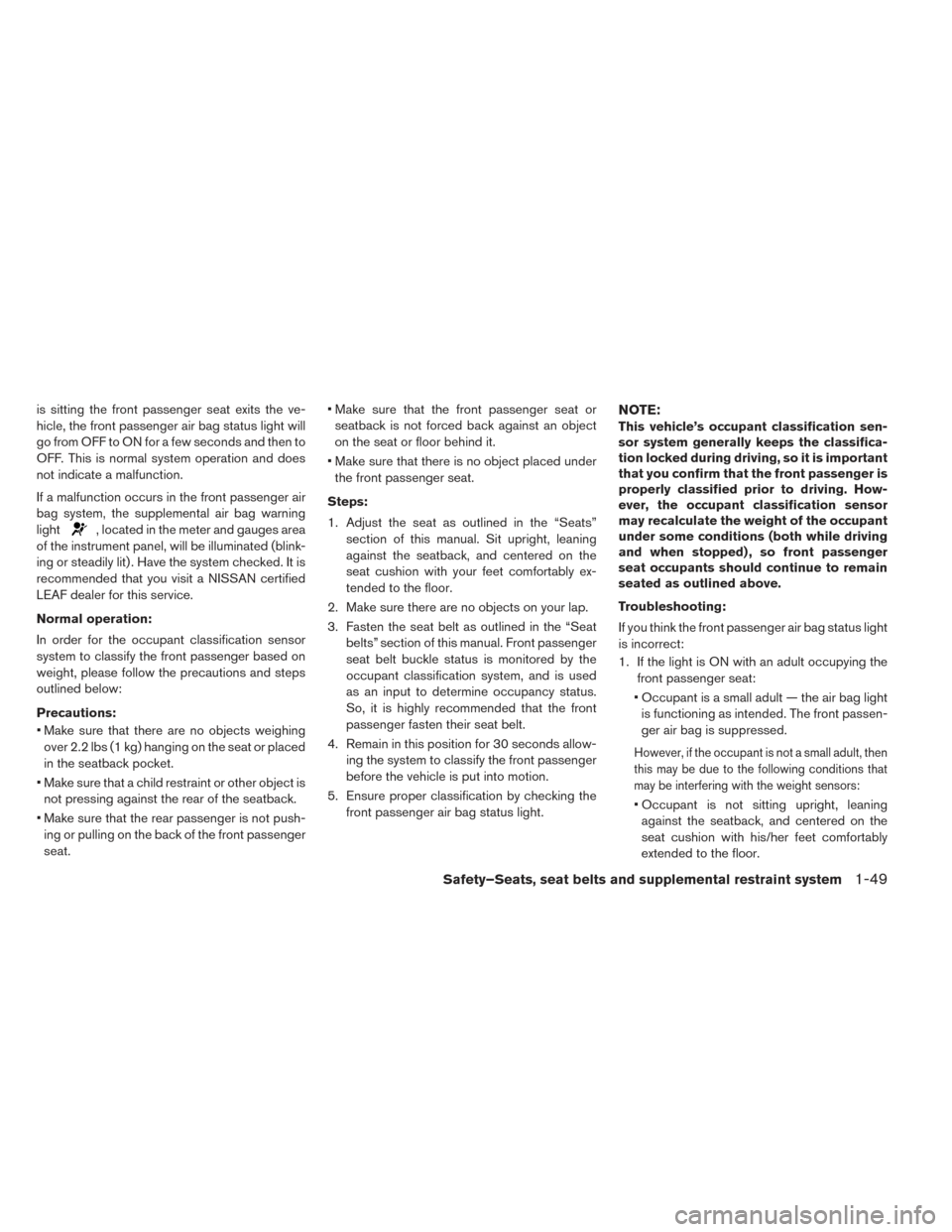
is sitting the front passenger seat exits the ve-
hicle, the front passenger air bag status light will
go from OFF to ON for a few seconds and then to
OFF. This is normal system operation and does
not indicate a malfunction.
If a malfunction occurs in the front passenger air
bag system, the supplemental air bag warning
light
, located in the meter and gauges area
of the instrument panel, will be illuminated (blink-
ing or steadily lit) . Have the system checked. It is
recommended that you visit a NISSAN certified
LEAF dealer for this service.
Normal operation:
In order for the occupant classification sensor
system to classify the front passenger based on
weight, please follow the precautions and steps
outlined below:
Precautions:
• Make sure that there are no objects weighing over 2.2 lbs (1 kg) hanging on the seat or placed
in the seatback pocket.
• Make sure that a child restraint or other object is not pressing against the rear of the seatback.
• Make sure that the rear passenger is not push- ing or pulling on the back of the front passenger
seat. • Make sure that the front passenger seat or
seatback is not forced back against an object
on the seat or floor behind it.
• Make sure that there is no object placed under the front passenger seat.
Steps:
1. Adjust the seat as outlined in the “Seats” section of this manual. Sit upright, leaning
against the seatback, and centered on the
seat cushion with your feet comfortably ex-
tended to the floor.
2. Make sure there are no objects on your lap.
3. Fasten the seat belt as outlined in the “Seat belts” section of this manual. Front passenger
seat belt buckle status is monitored by the
occupant classification system, and is used
as an input to determine occupancy status.
So, it is highly recommended that the front
passenger fasten their seat belt.
4. Remain in this position for 30 seconds allow- ing the system to classify the front passenger
before the vehicle is put into motion.
5. Ensure proper classification by checking the front passenger air bag status light.
NOTE:
This vehicle’s occupant classification sen-
sor system generally keeps the classifica-
tion locked during driving, so it is important
that you confirm that the front passenger is
properly classified prior to driving. How-
ever, the occupant classification sensor
may recalculate the weight of the occupant
under some conditions (both while driving
and when stopped) , so front passenger
seat occupants should continue to remain
seated as outlined above.
Troubleshooting:
If you think the front passenger air bag status light
is incorrect:
1. If the light is ON with an adult occupying thefront passenger seat:
• Occupant is a small adult — the air bag light is functioning as intended. The front passen-
ger air bag is suppressed.
However, if the occupant is not a small adult, then
this may be due to the following conditions that
may be interfering with the weight sensors:
• Occupant is not sitting upright, leaningagainst the seatback, and centered on the
seat cushion with his/her feet comfortably
extended to the floor.
Safety–Seats, seat belts and supplemental restraint system1-49
Page 134 of 424
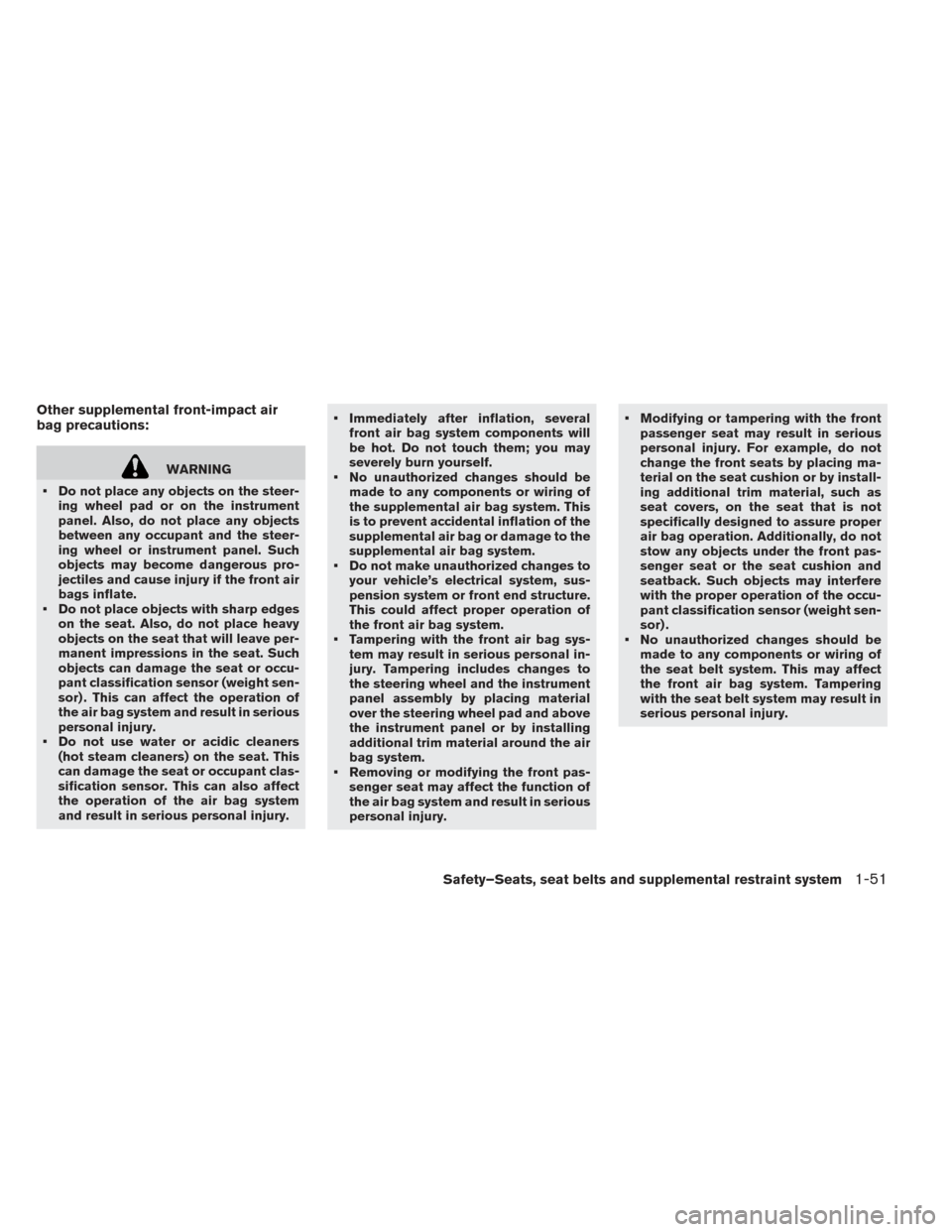
Other supplemental front-impact air
bag precautions:
WARNING
• Do not place any objects on the steer- ing wheel pad or on the instrument
panel. Also, do not place any objects
between any occupant and the steer-
ing wheel or instrument panel. Such
objects may become dangerous pro-
jectiles and cause injury if the front air
bags inflate.
• Do not place objects with sharp edges on the seat. Also, do not place heavy
objects on the seat that will leave per-
manent impressions in the seat. Such
objects can damage the seat or occu-
pant classification sensor (weight sen-
sor) . This can affect the operation of
the air bag system and result in serious
personal injury.
• Do not use water or acidic cleaners (hot steam cleaners) on the seat. This
can damage the seat or occupant clas-
sification sensor. This can also affect
the operation of the air bag system
and result in serious personal injury. • Immediately after inflation, several
front air bag system components will
be hot. Do not touch them; you may
severely burn yourself.
• No unauthorized changes should be made to any components or wiring of
the supplemental air bag system. This
is to prevent accidental inflation of the
supplemental air bag or damage to the
supplemental air bag system.
• Do not make unauthorized changes to your vehicle’s electrical system, sus-
pension system or front end structure.
This could affect proper operation of
the front air bag system.
• Tampering with the front air bag sys- tem may result in serious personal in-
jury. Tampering includes changes to
the steering wheel and the instrument
panel assembly by placing material
over the steering wheel pad and above
the instrument panel or by installing
additional trim material around the air
bag system.
• Removing or modifying the front pas- senger seat may affect the function of
the air bag system and result in serious
personal injury. • Modifying or tampering with the front
passenger seat may result in serious
personal injury. For example, do not
change the front seats by placing ma-
terial on the seat cushion or by install-
ing additional trim material, such as
seat covers, on the seat that is not
specifically designed to assure proper
air bag operation. Additionally, do not
stow any objects under the front pas-
senger seat or the seat cushion and
seatback. Such objects may interfere
with the proper operation of the occu-
pant classification sensor (weight sen-
sor) .
• No unauthorized changes should be made to any components or wiring of
the seat belt system. This may affect
the front air bag system. Tampering
with the seat belt system may result in
serious personal injury.
Safety–Seats, seat belts and supplemental restraint system1-51
Page 138 of 424
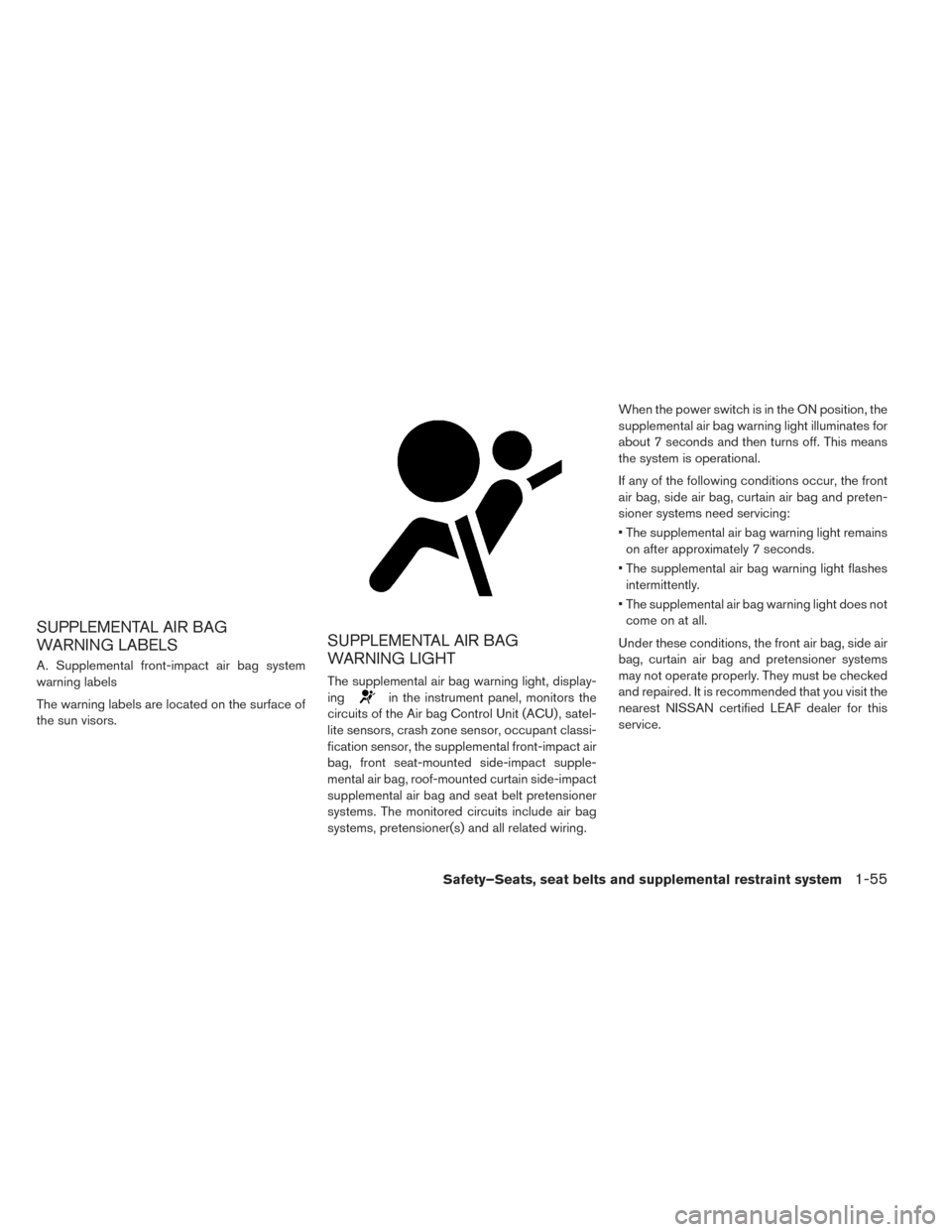
SUPPLEMENTAL AIR BAG
WARNING LABELS
A. Supplemental front-impact air bag system
warning labels
The warning labels are located on the surface of
the sun visors.
SUPPLEMENTAL AIR BAG
WARNING LIGHT
The supplemental air bag warning light, display-
ing
in the instrument panel, monitors the
circuits of the Air bag Control Unit (ACU) , satel-
lite sensors, crash zone sensor, occupant classi-
fication sensor, the supplemental front-impact air
bag, front seat-mounted side-impact supple-
mental air bag, roof-mounted curtain side-impact
supplemental air bag and seat belt pretensioner
systems. The monitored circuits include air bag
systems, pretensioner(s) and all related wiring. When the power switch is in the ON position, the
supplemental air bag warning light illuminates for
about 7 seconds and then turns off. This means
the system is operational.
If any of the following conditions occur, the front
air bag, side air bag, curtain air bag and preten-
sioner systems need servicing:
• The supplemental air bag warning light remains
on after approximately 7 seconds.
• The supplemental air bag warning light flashes intermittently.
• The supplemental air bag warning light does not come on at all.
Under these conditions, the front air bag, side air
bag, curtain air bag and pretensioner systems
may not operate properly. They must be checked
and repaired. It is recommended that you visit the
nearest NISSAN certified LEAF dealer for this
service.
Safety–Seats, seat belts and supplemental restraint system1-55